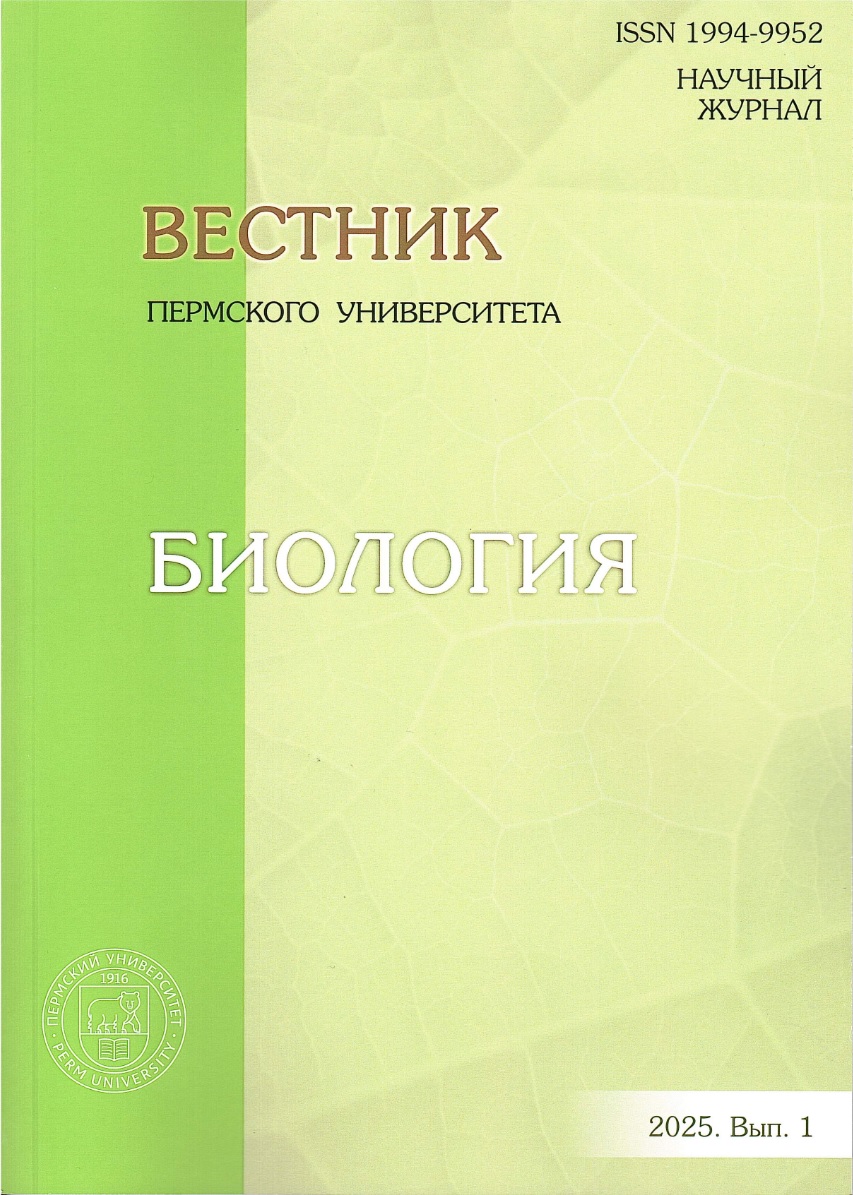Monitoring of ectomycorrhizal fungi in some types of spruce forests (Subzone of the Southern Taiga, Perm Territory, Russia)
Main Article Content
Abstract
Article Details
References
Воронина Е.Ю. Симбиотрофные макромицеты и эктомикоризы основных пород в сложных ельни-ках на территории лесного массива Звенигородской биологической станции Московского государствен-ного университета // Микология и фитопатология. 2004. Т. 38, вып. 3. С. 10–18. EDN: MPTUFX.
Грейг-Смит П. Количественная экология растений. М.: Мир, 1967. 359 с.
Иванов А.И. Агарикомицеты Приволжской возвышенности. Порядок Boletales. Пенза, 2014. 178 с. ISBN: 978-5-94338-660-2. EDN: VYHVNX.
Иванов А.И. Плодоношение агарикомицетов (Agaricomycetes) в природных сообществах Пензен-ской области в связи с циклами солнечной активности и погодными условиями // Микология и фитопато-логия. 2016. Т. 50, вып. 4. С. 219–229. EDN: WHJOFH.
Иллюстрированный определитель растений Пермского края / С.А. Овеснов, Е.Г. Ефимик, Т.В. Козьминых и др.; под ред. С.А. Овеснова. Пермь: Кн. мир, 2007. 743 с. ISBN: 5-93824-074-3. EDN: VYCNOF.
Коваленко А.Е. Экологический обзор грибов из порядков Polyporales s. str., Boletales, Agaricales s. str., Russulales в горных лесах центральной части Северо-Западного Кавказа // Микология и фитопато-логия.1980. Т. 14, вып. 4. С. 300–314. EDN: TZNLZV.
Леонтьев Д.В. Флористический анализ в микологии. Харьков: ПП РанокНТ, 2008. 110 с.
Морозова О.В. Агарикоидные базидиомицеты подзоны южной тайги Ленинградской области: ав-тореф. дис. … канд. биол. наук. СПб., 2001. 27 с. EDN: QDXDZT.
Новожилов Ю.К. и др. Скрытое разнообразие грибов и грибообразных протистов в природных эко-системах: проблемы и перспективы // Биосфера. 2016. Т. 8, № 2. С. 202–215. EDN: WKNRHP.
Переведенцева Л.Г. Биота и экология агарикоидных базидиомицетов Пермской области: автореф. дис. … д-ра биол. наук. М., 1999. 48 с. EDN: NLOSAD.
Селиванов И.А. Микосимбиотрофизм как форма консортивных связей в растительном покрове Советского Союза. М.: Наука, 1981. 231 с.
Смит С.Э., Рид Д.Дж. Микоризный симбиоз. М.: КМК, 2012. 776 с. ISBN: 978-5-87317-861-2. EDN: QKVAWZ.
Столярская М.В., Коваленко А.Е. Грибы Нижнесвирского заповедника. Вып. 1. Макромицеты: ан-нотированные списки видов. СПб, 1996. 59 с.
Сукачев В.Н., Зонн Е.В. Методические указания к изучению типов леса. М.: Изд-во АН СССР, 1961. 144 с.
Трухачева Н.В. Математическая статистика в медико-биологических исследованиях с примене-нием пакета Statistica. М.: ГЭОТАР-Медиа, 2013. 384 с. ISBN: 978-5-9704-2133-8. EDN: THVXOF.
Фомина Е.А. Эктомикоризные грибы еловых лесов Карельского перешейка (Ленинградская об-ласть). Видовое разнообразие // Микология и фитопатология. 2001. Т. 35, вып. 1. С. 43–51.
Фомина Е.А. Эктомикоризные грибы еловых лесов Ленинградской области: автореф. дис. … канд. биол. наук. СПб., 2000. 22 с. EDN: QDBOYL.
Шишигин А.С. Мониторинг агарикоидных базидиомицетов в некоторых типах коренных и произ-водных лесов подзоны южной тайги (Пермский край): автореф. дис. … канд. биол. наук. М., 2021. 20 с.
Шубин В.И. Значение симбиоза и содержания в почве азота для плодоношения эктомикоризных грибов. I. Значение симбиоза // Микология и фитопатология. 2010. Т. 44, вып. 2. С. 130–136. EDN: OJARAJ.
Шубин В.И. О плодоношении эктомикоризны.х грибов // Хвойные бореальной зоны. 2009. Т. 26, № 1. С. 29–32. EDN: KJVPLX.
Bochus G., Babos M. Coenology of terricolous macroscopic fungi of deciduous forests. Contributions to our knowledge of their behavior in Hungary // Bot. Jahrb. System. Pflanzengeschichte und Pflanzengeographie. 1960. Bd. 80, № 1. S. 1–100.
Botalov V.S., Perevedentseva L.G., Shishigin A.S. Change in the Structure and Productivity of the Biota of Agaricoid Basidiomycetes According to the Results of Long-Term Monitoring in Pine Forests of Perm Oblast (Southern Taiga Subzone) // Contemporary Problems of Ecology. 2018. Vol. 11, Iss. 5. P. 600–609. DOI: 10.1134/S1995425518050050. EDN: YHYMHO.
Botalov V.S., Perevedentseva L.G., Shishigin A.S. Monitoring the structure and productivity of biota of agaricoid basidiomycetes i1n spruce forests of the subzone of the southern taiga of the Perm Krai // Contempo-rary Problems of Ecology. 2020. Vol. 13, iss. 6. P. 484–493. DOI: 10.1134/S1995425520060050. EDN: AZSCNY.
Moser M. Die Rohrlinge und Blätterpilze (Polyporales, Boletales, Agaricales, Russulales) // Kleine Kryp-togamenflora. Bd. 2b. 2. Stuttgart, New York, 1983. 533 s.
MycoBank Database [Электронный ресурс]. URL: http//www.mycobank.org (дата обращения: 04.01.2025).
Straatsma G., Ayer F., Egli S. Species richness, abundance, and phenology of fungal fruit bodies over 21 years in a Swiss forest plot // Mycological Research. 2001. Vol. 105, № 5. P. 515–523. DOI: 10.1017/S0953756201004154. EDN: FOKYVZ.
Straatsma G., Krisai-Greilhuber I. Assemblage structure, species richness, abundance, and distribution of fungal fruit bodies in a seven-year plot-based survey near Vienna // Mycological Research. 2003. Vol. 107, № 5. P. 632–640. DOI: 10.1017/S0953756203007767. EDN: FOLFNL.




